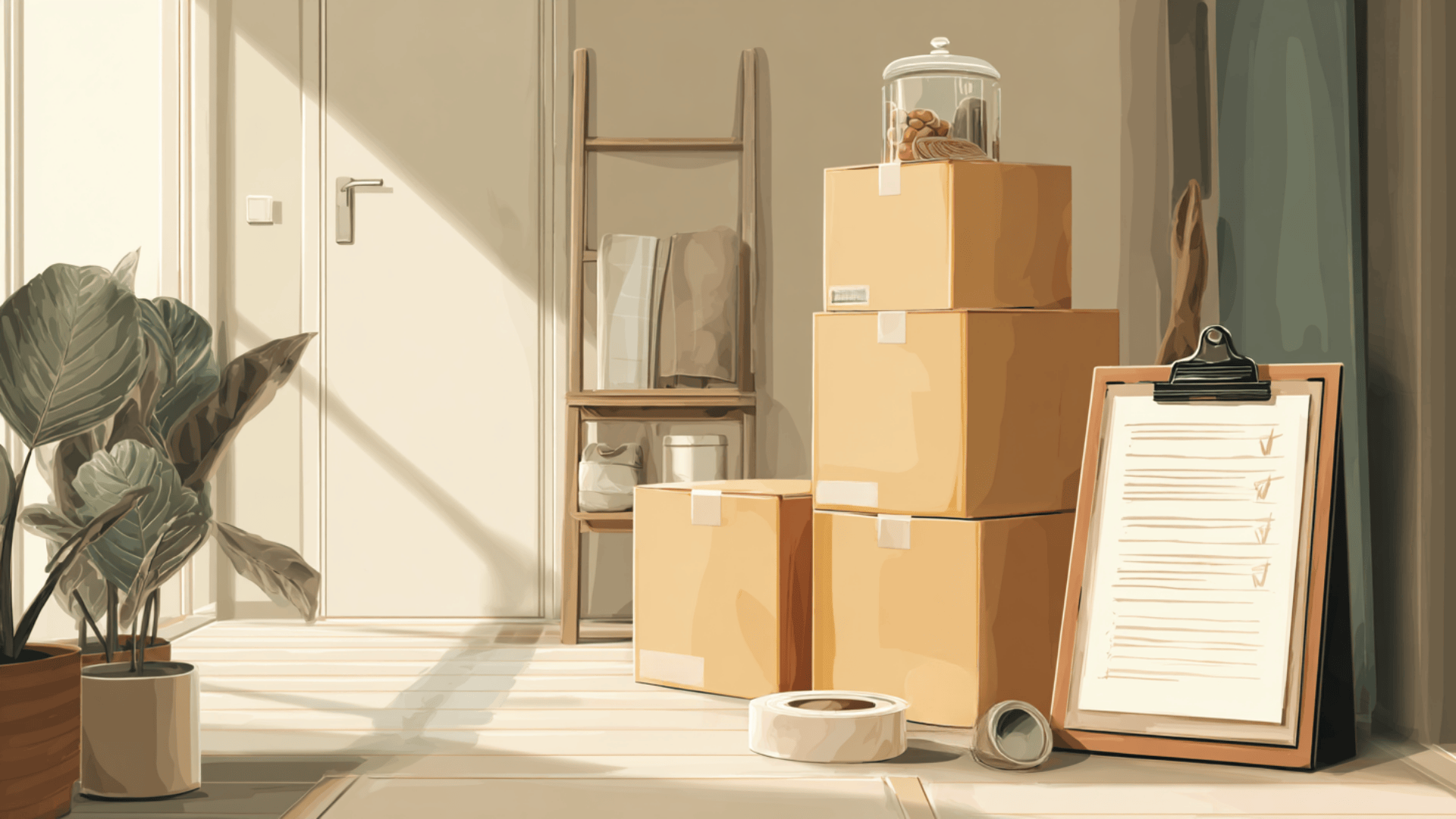Packing for a move can feel like a puzzle, where every piece has to fit just right. Between sorting, wrapping, and labeling, it’s easy to feel buried before you even start.
The secret to how to pack for a move isn’t speed or strength: it’s strategy. With the right approach, you can pack efficiently, protect your belongings, and keep your sanity intact.
Here, I’ll walk you through every step, from creating a smart plan and staying organized to unpacking smoothly once you arrive. You’ll also pick up simple hacks that save time, space, and effort along the way.
How to Move: Considerations Before You Start Packing
Before you jump into boxes and tape, take a minute to get organized. Moving can feel messy fast, but a little planning up front saves you hours later.
It helps to slow down, look around your place, and think through what’s really coming with you. You’ll pack smarter, waste fewer supplies, and make unpacking way easier.
Once you’ve got that mindset, it’s time to start with the first step: building a simple moving plan.
How to Pack for A Move: Step-By-Step Guide

Before you start boxing things up, let’s go over the simple steps that make packing smoother and stress-free.
Step 1: Create Your Moving Plan
Before you start taping up boxes, take a little time to plan things out. Even a bit of prep makes the whole process easier and less stressful. Think of this as your roadmap for moving day.
Decide on Your Moving Date and Timeline
Pick your move-out date and work backward from there. Once you know your deadline, you can set small weekly goals, like when to pack each room or when to book a truck.
If you’re renting, double-check your lease end date so you don’t run into extra fees.
Choose DIY vs. Professional Movers
Ask yourself if you want to do all the lifting or hire help.
- If you’re on a tight budget and don’t have a lot of heavy stuff, DIY can work.
- If you have large furniture, appliances, or a long-distance move, a moving company can save time and effort. Get a few quotes early; movers book up quickly around weekends and month-end.
Make a Packing Calendar
A packing calendar helps you break the job into small, easy steps.
- Start with one or two rooms each week.
- Add reminders for things like picking up supplies or canceling utilities.
Step 2: Declutter and Organize Before Packing
Before you start putting things in boxes, clear out what you don’t need. I’ve learned that moving is the best time to get rid of clutter. The less you pack, the less you’ll have to unpack later.
Room-By-Room Decluttering
Go through one room at a time. It keeps you from feeling overwhelmed and helps you stay focused.
Set aside separate piles for items you’ll keep, donate, or toss.
Donation, Recycling, or Disposal Tips
- Donate gently used clothes, furniture, and kitchen items to local charities.
- Recycle papers, electronics, and batteries properly.
- Throw away broken or expired items that can’t be reused.
How to Decide What Stays or Goes
If you haven’t used something in a year, it might be time to let it go.
Ask yourself: “Do I really need this in my new place?” If the answer’s no, it’s not worth packing.
Step 3: Gather the Right Packing Supplies
You don’t need fancy tools to pack well, but the right supplies make a big difference. Having everything ready before you start saves a ton of time.
Make sure you have enough supplies for the whole house.
- Small, medium, and large boxes
- Packing tape and scissors
- Bubble wrap or paper
- Labels and markers
- Trash bags and zip ties
Smart Alternatives: Suitcases, Laundry Baskets, Reusable Bins
Use what you already have.
- Fill suitcases with clothes and shoes
- Pack towels or bedding in laundry baskets
- Store heavy items in sturdy plastic bins
Eco-Friendly Options: Compostable Wrap, Newspaper Padding
If you want to cut down on waste, try:
- Wrapping items in old newspapers or towels
- Using compostable packing materials
- Reusing boxes from local stores
Step 4: Follow a Packing Timeline
Packing always takes longer than you expect, so having a timeline helps. I like to break it down by week; it keeps the process calm and organized.
1-Month Before: Non-Essentials
Start with things you don’t use every day.
- Books, décor, seasonal clothes, and holiday items
- Extra bedding, linens, or hobby supplies
2-Weeks Before: Less-Used Rooms
Now move on to rooms you don’t need often.
- Guest rooms, dining rooms, or storage spaces
- Label each box with its contents and room name
1-Week Before: Everyday Items
It’s time to pack the kitchen, bathrooms, and your main bedroom.
- Keep a few essentials out for daily use
- Start sealing boxes and stacking them by the door
Moving Day: Final Essentials
Pack the last items: cleaning supplies, snacks, and documents. Do a final walk-through to make sure nothing’s left behind.
Step 5: Pack Room by Room (With Tips)
Packing one room at a time keeps things simple. You’ll know where everything belongs when it’s time to unpack.
1. Kitchen: Wrap dishes vertically in bubble wrap or paper. Stack pots inside each other and fill gaps with towels. Label fragile boxes clearly.
2. Bedroom: Keep clothes on hangers by sliding them into trash bags. Use wardrobe boxes for formal wear. Pack shoes in small boxes to keep pairs together.
3. Living Room: Unplug electronics and wrap cords neatly. Use blankets or cushions to protect TVs and lamps. Remove batteries from remotes before packing.
4. Bathroom: Seal liquids and toiletries in plastic bags. Pack towels and rugs together. Throw out expired products.
5. Garage/Attic: Handle tools and liquids carefully. Use small boxes for heavy tools. Don’t pack flammable or hazardous materials.
Step 6: Protect Fragile and Valuable Items
Breakables need extra care. I always take my time here; it’s worth it when everything arrives safely.
How to Wrap Glass, Mirrors, and Art
Wrap each piece in paper or bubble wrap. For mirrors and frames, tape an “X” on the glass to help prevent shattering.
Use of Towels or Socks for Padding
Soft items work great as cushioning. Use socks for glasses and towels for plates and bowls.
List of “Do Not Pack” or Restricted Items
Avoid packing:
- Paints, cleaning chemicals, and aerosols
- Perishable food
- Important documents (keep them with you)
Step 7: Label and Track Boxes Efficiently
Labeling makes unpacking so much easier. I’ve made the mistake of skipping this step before; it’s not fun trying to find your toothbrush in a sea of boxes.
- Labeling by Color or Number: Use a color for each room or number your boxes. Write the room name and a few key items on each label.
- QR Codes or Inventory Spreadsheet: If you like tech tools, use QR labels or a tracking app. You can scan boxes and see exactly what’s inside.
- Mark Priority Boxes (“Open First”): Set aside boxes for essentials, like bedding, towels, or kitchen gear. Mark them clearly so you know what to unpack first.
Step 8: Pack an Essentials Box
This is your survival kit for the first night. I always keep it close so I don’t have to dig for basics.
Pack enough for a couple of days. Add things like:
- Toothbrush and toiletries
- A few changes of clothes
- Chargers and devices
- Basic snacks and medications
- Important papers and keys
Kids and pets need their own essentials. Include toys, food, or comfort items to make them feel at home.
Step 9: Moving Day Tips
Moving day can get hectic, but a few smart steps make it smoother. I always keep these things in mind:
Checking Inventory
Before you start loading the truck, go over your inventory list one last time.
- Check off each box as it leaves the house.
- Make sure fragile boxes are clearly marked and handled carefully.
- Keep your list handy so you can confirm everything arrives at the new place.
A quick double-check now saves a lot of confusion later when you’re unpacking.
Keeping Valuables with You
Always keep important and personal items with you during the move. That includes jewelry, passports, IDs, keys, chargers, and any paperwork you might need right away.
If you’re driving, pack these in a small bag or tote you can easily reach. I’ve learned that peace of mind comes from knowing your essentials aren’t buried in a moving truck somewhere.
Managing Helpers or Movers
Whether you’ve got friends helping or hired professionals, a little direction goes a long way.
- Walk them through your home and point out fragile or priority boxes.
- Label doors in your new house (like “Kitchen” or “Bedroom”) to guide where boxes go.
- Keep water, snacks, or a small tip ready for movers; it’s a simple gesture that keeps morale high.
Taking a few minutes to coordinate saves time, prevents mix-ups, and helps the day move along without chaos.
Step 10: Unpacking Smartly
You’ve made it through moving day, and now it’s time to settle in. Unpacking can feel like a second move, but if you go room by room, it’s much easier to handle.
Start with the spaces that make daily life comfortable: your bedroom and kitchen.
- Set up your bed first so you have a clean place to rest after a long day.
- Next, unpack kitchen essentials like plates, cups, a few pots, and utensils. Once those areas are ready, move on to the bathroom and living spaces.
Tackling your most-used rooms first helps you feel at home faster, even if the rest is still in boxes. As you unpack, break down empty boxes and stack them neatly.
- Recycle what you can, especially cardboard and paper.
- If your boxes are still in good shape, post them online or offer them to a neighbor who’s moving soon.
Getting rid of boxes as you go keeps your new place tidy and open.
Simple Post-Move Cleaning Checklist
Before arranging furniture or décor, give each room a quick clean.
- Wipe shelves, countertops, and drawers.
- Vacuum carpets and sweep floors.
- Clean ceiling fans, vents, and light fixtures; they collect more dust than you’d expect.
A light cleanup not only freshens the space but helps you start this new chapter feeling organized and relaxed.
Download Your Free Moving Checklist
Packing for a move is easier when you have everything organized in one place. This printable checklist covers every step from planning and decluttering to packing, labeling, and unpacking, so nothing gets missed.
You can download it, print it, or save a digital copy to check off items as you go. It’s a simple way to stay on track, reduce stress, and make your move feel smooth from start to finish.
Moving Tips and Common Mistakes to Avoid

- Packing too late: Start early so you don’t end up throwing things together at the last minute. Packing a few boxes each day keeps stress low and your move on track.
- Forgetting to label: Always label boxes with both the room and contents. It saves hours of guessing later and makes unpacking much smoother.
- Overfilling boxes: Keep box weight manageable to avoid tears and injuries. Use smaller boxes for heavy items and larger ones for light stuff.
- Ignoring insurance coverage: Check what your movers or rental company covers. A little extra protection for valuables gives you peace of mind.
Small steps like these make a big difference. Staying ahead of these mistakes means your move will feel smoother, lighter, and a lot less stressful.
Conclusion
Moving doesn’t have to feel overwhelming when you plan ahead, stay organized, and pace yourself through each stage.
The key to knowing how to pack for a move is finding a system that fits your lifestyle, whether that means packing a little each day, using eco-friendly materials, or color-coding your boxes.
Focus on what helps you stay calm and in control, not just what gets the job done fastest. Once everything’s in its place, you’ll have more energy to enjoy your new space.
If you found these tips helpful, read my other blogs for more simple, practical guides on home organization, maintenance, and moving.





